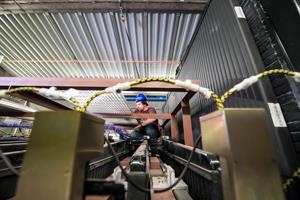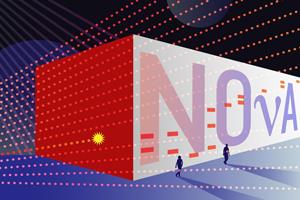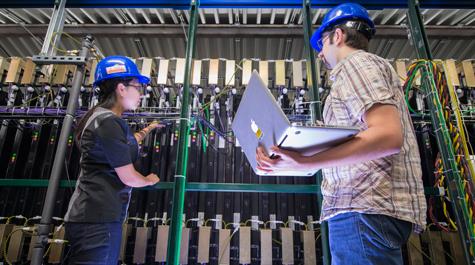Fermilab is 'ecstatic' over first NOvA neutrino results
Fermilab presented an analysis of the first results from its NOvA neutrino experiment on Aug. 7 and physicists from William & Mary were heavily involved.
“People are ecstatic to see our first observation of neutrino oscillations,” said NOvA co-spokesperson Peter Shanahan of the U.S. Department of Energy’s Fermi National Accelerator Laboratory in a Fermilab release. “For all the people who worked over the course of a decade on the designing, building, commissioning, and operating this experiment, it’s beyond gratifying.”
 Those ecstatic people include Patricia Vahle, associate professor of physics at William & Mary, who convened the analysis. A postdoctoral researcher working with her, Alex Radovic, is working on the NOvA project and was chosen to write a piece explaining the results for Fermilab Today. Vahle’s Ph. D. student Ji Liu is writing her thesis on the analysis. Liu also worked on the construction and assembly of one of the NOvA neutrino detectors, as did Marco Coló, a Ph.D. student who works with Jeffrey Nelson, a professor of physics who was involved in NOvA at the planning stages.
Those ecstatic people include Patricia Vahle, associate professor of physics at William & Mary, who convened the analysis. A postdoctoral researcher working with her, Alex Radovic, is working on the NOvA project and was chosen to write a piece explaining the results for Fermilab Today. Vahle’s Ph. D. student Ji Liu is writing her thesis on the analysis. Liu also worked on the construction and assembly of one of the NOvA neutrino detectors, as did Marco Coló, a Ph.D. student who works with Jeffrey Nelson, a professor of physics who was involved in NOvA at the planning stages.
They’re all members of William & Mary’s Experimental High Energy Physics Group. Nelson and Vahle, along with Associate Professor Michael Kordosky, just received the first installment of a three-year, $1.4 million grant from the National Science Foundation to continue work on NOvA and other neutrino experiments.
NOvA is based at the U.S. Department of Energy’s Fermilab complex in Batavia, Illinois. It’s one of several experiments going on across the world to understand neutrinos. Neutrinos are subatomic particles generated by sources that range from nuclear power reactors to the sun to the Big Bang.
Neutrinos are unimaginably numerous, but their infrequent interaction with matter make the particles a challenge to study. Neutrinos exist in three “flavors:” muon, electron and tau. The NOvA experiment aims to investigate one of the peculiar properties of neutrinos — their tendency to change flavors, or oscillate. NOvA is what the physicists call a long-baseline experiment, as the neutrinos travel more than 500 miles underground.
“We make a beam of muon-type neutrinos at Fermilab, and then we detect those at Ash River, Minnesota,” Vahle explained. “We are looking for muon-type neutrinos to change into electron-type neutrinos. We also look for those muon neutrinos to just disappear, or really change into any type of neutrino.”
 The initial results from NOvA were announced to the Fermilab community on Aug. 6 and to the wider scientific world on Aug. 7 at the meeting of the American Physical Society’s Division of Particles and Fields at Ann Arbor, Michigan. The results show that the experiment is emitting and detecting neutrinos, as designed.
The initial results from NOvA were announced to the Fermilab community on Aug. 6 and to the wider scientific world on Aug. 7 at the meeting of the American Physical Society’s Division of Particles and Fields at Ann Arbor, Michigan. The results show that the experiment is emitting and detecting neutrinos, as designed.
“Basically, it shows that we know what we’re doing,” Vahle said. The results verify that NOvA is picking up neutrinos that have oscillated. She said that the physicists had determined that if no muon neutrinos were oscillating between the beam source and Ash River, the far detector would pick up a single background oscillation event from the beam.
“If this muon-to-electron oscillation is not occurring, we would see one event in the far detector, OK?,” Vahle said. “It turns out, for the primary analysis, we see six events.”
She went on to explain that the secondary analysis, essentially a cross check of the muon-to-electron oscillation, showed an even greater excess over background.
Nelson said that a comprehensive understanding of the complex behavior of neutrinos could shed light on some of the most fundamental questions of cosmology.
“One of the big questions of the universe is this: Why is there matter?” Nelson said. “Why is there stuff? Matter and antimatter could have just annihilated and we’d be left with nothing in the universe but energy. If the answer isn’t in neutrinos, it’s something really exotic.”
Want to know more about how NOvA works? Here’s an explanatory Fermilab video. Skip to main content
Skip to main content

